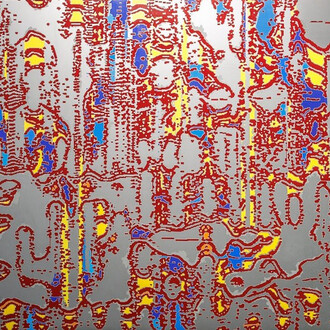The exhibition has been organized by the State Hermitage with the support of the State Pushkin Museum of Fine Arts, the Tambov Regional Art Gallery and the National Library of Russia. Altogether the display includes some 250 items – paintings, sculpture, works of applied art, watercolours and photographs.
The present exhibition is a tribute to Count Pavel Sergeevich Stroganov (1823–1911), “a noble defender of the arts”, a considerable portion of whose collection has found its way into the Hermitage. That collection, which was put together in the middle and third quarter of the 19th century, has been undeservedly forgotten, although it not only reflected the tastes of the period, but also gave our museum a number of remarkable works of painting and sculpture.
It is possible to surmise that Stroganov quite consciously selected paintings that he intended to go to the Hermitage. They not only possessed great artistic merits, but also filled gaps in the museum’s art gallery. One of the masterpieces of the collection should be considered to be the Adoration of the Christ-Child by the Florentine artist of the second half of the 15th century Filippino Lippi. His Venetian contemporary Giovanni Battista Cima da Conegliano painted the monumental Lamentation (Pushkin Museum of Fine Arts). An important addition to the Hermitage’s rich collection of 17th-century Dutch art was Forest by Meindert Hobbema, an artist previously unrepresented in the museum. Count Stroganov’s donation was one of the most significant augmentations of the Hermitage’s stocks in the early 20th century.
Pavel Stroganov’s collection contained priceless examples of Russian and European (including Italian Renaissance) painting, sculpture and applied art, Chinese ceramics and a unique assemblage of books.
The most valuable part of the collection was the paintings. The Count spent several years in Italy. He developed an interest in early Italian painting and acquired a number of works by 14th- and 15th-century artists of the Sienese and Florentine schools. Later, in Paris and St Petersburg, he also bought 15th- and 16th-century paintings of the Netherlandish and German schools and also put together a small, but good-quality collection of 17th-century Dutch art. Pavel Stroganov was keenly interested in landscape painting and so his collection also included pictures by contemporary Italian painters, mainly those associated with the School of Posillipo (Giacinto Gigante, Gabriele Smargiassi, Ippolito Caffi).
While still in Italy, Stroganov began to buy works by Russian artists – Silvester Shchedrin, Lev Lagorio and Karl Briullov. The exhibition features a portrait of Count Pavel Stroganov that Briullov painted in 1850. The artist depicted the young diplomat with undoubted affection and invested him with a romantic and somewhat dreamy appearance. Back in Russia the Count also provided support to the landscape artist Feodor Vasilyev, who lived and worked on Stroganov’s estate near Tambov.
In 1857–59 Pavel Stroganov had a house built for himself in Saint Petersburg to the design of the architect Ippolito Monighetti on Sergiyevskaya Street (now Tchaikovsky Street), close to the Summer Garden. The building was later extended upwards, with the addition of two more storeys, and changed its appearance, but its interiors have partially survived down to the present, albeit seriously damaged. That mansion housed the works of Italian and Netherlandish artists of the 14th–16th centuries, which the collector clearly found interesting to display alongside each other.
The Hermitage possesses an important visual record of the appearance of the majority of the rooms in Count Stroganov’s mansion in the form of watercolours painted by Jules Mayblom between 1863 and 1865. The exhibition is the first time that all those pictures of the mansion are being shown. The painstakingly executed views of the rooms not only provided evidence of the interior decoration, but also make it possible to identify paintings, sculptures and works of applied art, which expands and supplements our knowledge of the collection.
Throughout his life Pavel Stroganov bought old and rare book. In 1880 he donated to the Imperial Hermitage a unique collection of auction catalogues from the sales of art collections in Europe (18th and 19th centuries). This collection of 1,750 printed publications and one manuscript had been created by Prince Alexander Lobanov-Rostovsky (1788–1866) and then expanded by the Count himself. According to one contemporary, it was “famed across Europe” and became the core of the extremely rich collection of auction catalogues in the Hermitage library. The most interesting publications that belonged to Count Stroganov are also on show in the exhibition.
In recent decades in Russia and abroad several exhibitions have been held devoted to the art collections of the Stroganov counts, with the most attention being paid to Count Alexander Sergeevich Stroganov, the President of the Academy of Arts who formed the foundation of the family collection. Meanwhile the name of Pavel Sergeevich Stroganov, an art patron and collector, has remained to this day little known to historians and lovers of art. The collection that he assembled and kept in his mansion on Sergiyevskaya Street in St Petersburg was moved in 1919, to the newly-created Stroganov Palace Museum on Nevsky Prospekt and as a result the paintings, sculptures and works of applied art lost their provenance. Now, however, it has become clear that it was Pavel Stroganov’s collection, along with that of his ancestor, Alexander Stroganov, that was fundamental to the artistic wealth to a family noted for its interest in art.
The exhibition curator is Fyodor Sergeevich Svetlakov, junior researcher in the State Hermitage’s Department of Western European Fine Art.
















